基于介电特性与SPA-SVR算法的水稻含水率检测方法
张本华,钱长钱,焦晋康,丁兆赫,张 扬,崔红光,刘翠红,冯龙龙
·农产品加工工程·
基于介电特性与SPA-SVR算法的水稻含水率检测方法
张本华,钱长钱,焦晋康,丁兆赫,张 扬,崔红光,刘翠红,冯龙龙
(沈阳农业大学工程学院,沈阳 110161)
为提高基于介电法水稻含水率的检测精度,以北粳3号水稻为研究对象,利用阻抗分析仪及自制同轴圆柱型电容器测量了不同含水率水稻在1 kHz~1 MHz频率下的相对介电常数及介质损耗因数。采用共生距离法划分了72个样本校正集和48个样本预测集。利用无信息变量消除法及连续投影法选取介电参数(、及和两者结合)的特征变量,分别利用所提取的特征变量以及单频、全频下的介电参数来建立预测水稻含水率的多元线性回归及支持向量机回归模型,分析模型的预测性能,并对最佳模型的含水率预测结果进行温度补偿。结果表明:基于与两者结合并利用连续投影法提取特征变量建立的支持向量机回归模型预测效果最佳,其预测集决定系数为0.980,预测均方根误差为0.403%。最佳预测模型对不同品种水稻的含水率预测值与烘干法测得的含水率实测值的绝对误差集中分布在±0.5%内,该研究可为粮食含水率的检测提供参考。
含水率;水稻;介电特性;连续投影法;支持向量机回归
0 引 言
水稻作为中国第一大粮食作物,其质量的好坏直接影响着水稻的价格与消费情况。而含水率作为影响水稻品质的重要因素,对水稻的储藏、运输、收购和加工有着极大的影响[1]。在中国,每年因水分检测技术的不完善而导致粮食发霉变质造成的产量损失高达107t,经济损失高达200亿元[2]。因此,精准检测含水率,有利于提高水稻品质,减少损失。
目前,粮食含水率快速检测方法主要包括电容法、电阻法、核磁共振法、微波法、红外法、中子法等。其中核磁共振法[3]存在仪器昂贵,保养费用高,需精确标定等问题;微波法[4]、红外法[5]、中子法[6]具有影响因素多等不足;电阻法[7]需将样品粉碎,不适于无损检测;电容法[8]具有分辨率高、价格便宜、动态响应快等特点。从快速性和经济性考虑,电容法是检测粮食含水率较为实用的方法。
电容法作为一种基于介电特性快速检测粮食含水率的方法,因其影响因素较多,数据处理技术不完善,故测量精度不理想。如何提高电容式粮食水分检测装置精度成为目前创新和突破的难点。国内外学者对电容式粮食水分传感器结构、影响因素、数据处理方法等方面进行了相关研究。在电容器结构方面,设计了电容传感器的不同结构并优化了其结构尺寸[9-16]。在影响因素方面,研究了电压、频率、温度、容积密度等因素对介电参数的影响[17-22]。麦智炜等[23]设计了一种不受堆积密度影响的电容式粮食水分检测装置。在数据处理方法方面,考虑到温度、容积密度等因素的影响,采用了多元回归、神经网络、支持向量机等数学方法来建立粮食水分检测模型[24-30]。
综上所述,传统的电容法多为用单一频率下的单一电参数来预测粮食含水率,数学模型单一,影响因素较多,检测精度不高。为此,本研究在优化同轴圆柱型电容器极板结构的基础上,采用阻抗分析仪研究水稻含水率与介电参数间的关系,并分别在单频、全频及多个特征频率下建立水稻含水率与介电参数间的多元回归模型。分析模型的预测效果,确定检测水稻含水率的最佳模型,并对预测结果进行温度补偿。以期为基于介电特性粮食含水率的在线实时检测提供参考。
1 材料与方法
1.1 试验材料
试验水稻品种为北粳3号,选取完整无损且饱满的水稻作为试验样品。将试验样品随机分为120个样本,每个样本300 g水稻,装于密封袋中保存在23 ℃的室温环境下。
1.2 试验仪器
试验采用日置IM3570阻抗分析仪(日置电机株式会社)、101型电热鼓风干燥箱(北京市永光明医疗仪器有限公司)、JJ523BC型精密分析天平(上海锐析仪器)、RGX-400强光人工气候箱(上海印溪仪器仪表有限公司)以及自制同轴圆柱型电容器。
1.3 电容器结构参数设计
为减小电容器极板的边缘效应对介电参数的影响,本研究采用自制同轴圆柱型电容器。结构如图1所示。同轴圆柱型电容器主要由内外极板、保护极板、内外同心圆筒、屏蔽极板等组成。内、外圆筒材料为亚克力,直径分别为80 mm、30 mm、筒长120 mm、厚为3 mm。内极板采用80 mm宽的长方形铜箔粘贴在内筒外壁;为利用有机玻璃的绝缘特性来减小电导等因素对介电特性的影响,外极板采用铜箔粘贴在外圆筒的整个外壁;内极板的上下两端对称粘贴18 mm的铜箔作为保护电极,以减小端部效应的影响。屏蔽电极安装在外极板的外侧来减小外加寄生电容及外界磁场的干扰。基座采用长方形有机玻璃板。内外极板分别通过铜箔与阻抗分析仪的低电位、高电位输出端相连;保护电极和屏蔽电极与阻抗分析仪的接地端相连。
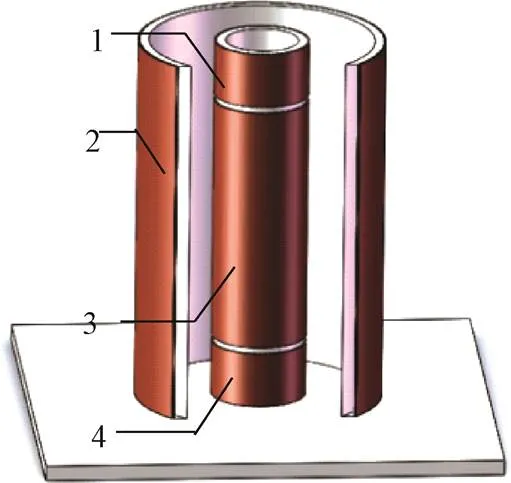
1.保护极板 2.外极板 3.内极板 4.保护极板
1.4 试验方法
1.4.1 不同含水率样品的制备
将水稻样品置于105 ℃的干燥箱内烘干24 h至质量恒定,根据烘干前后的质量差计算水稻湿基含水率,每份样品测3次取平均值,测得水稻的初始含水率为11.04%。为配制不同含水率的样品,取120份(每份300 g)水稻样品,每份样品添加不同质量的去离子水,得到120组不同含水率的样品(当配制样本的含水率大于16%时,需多次少量边搅拌边添加。将配制的样品装入双层密封袋中放置于5℃气候箱中2~3 d,期间每天搅动4~5次,使样品吸水均匀)。采用烘干法对120组水稻样品采样抽检,所制备的水稻湿基含水率为11.04%~23.70%,平均值为17.39%。
1.4.2 介电参数测量方法
介电参数的测量系统主要由阻抗分析仪、自制同轴圆柱型电容器以及计算机等组成。测量前,将阻抗分析仪预热30 min,并对探头进行短路、断路校正以及50 Ω负载校准。测量时,首先激励电压设置为1 V,利用阻抗分析仪测量在1 kHz~1 MHz内201个对数频率下的空筒电容0,然后将水稻样品以自由落体的方式倒入电容器的介质空腔内,并用刮板刮平,测量样品的电容(C)及介质损耗角正切(tan)。每个水稻样品测3次取平均值作为测量结果。由式(1)和式(2)计算出相对介电常数及介质损耗因数。


1.5 数据处理及建模方法
1.5.1 数据处理方法
因在所选频率范围内的(或)存在一定的相关性,某个频率对应的(或)可由其他频率下的(或)共同表示,该频率下的介电参数称为冗余信息,冗余信息会增加模型的复杂度[31]。因此对原频谱的信息进行筛选十分重要。本研究采用连续投影法(successive projection algorithm,SPA)及无信息变量消除法(uninformative variables elimination,UVE)来选取特征变量。SPA是一种使矢量空间共线性最小化的前向变量选择算法,能够提取全频率的几个特征频率,消除原始频谱矩阵中冗余信息,解决变量间的共线性问题[32]。UVE是基于偏最小二乘回归系数的算法,以消除无用信息。在选取变量时,UVE综合考虑了噪声和目标含水率的信息,比较直观实用[33]。
1.5.2 建模方法
常用的建模方法主要有多元线性回归、偏最小二乘回归、主成分回归、人工神经网络、支持向量机回归等。考虑到多元线性回归模型简单,支持向量机回归模型泛化能力强。因此,本研究分别采用多元线性回归(multiple linear regression,MLR)和支持向量机回归法(support vector regression,SVR)来建立水稻含水率的线性和非线性预测模型。比较分析其预测效果。以校正集的决定系数(R2)和校正均方根误差(root mean square error of calibration,RMSEC)及预测集的决定系数(R2)和预测均方根误差(root mean square error of predication,RMSEP)作为评价模型性能的指标。R2和R2越接近1,RMSEC和RMSEP越小,模型精度越高。
2 结果与分析
2.1 频率与含水率对水稻介电参数的影响
频率对不同含水率水稻及的影响曲线如图2、图3所示。
由图2可知,在1 kHz~1 MHz频段内,随着频率的增大而减小;这主要因当电介质处于外加交流电场时,其表面会发生离子、原子、空间电荷及偶极子极化,当频率较高时,偶极子极化滞后于电场的变化,导致随频率的增大而减小。频率相同时,水稻含水率越大,越大。主要由于含水率的增大导致水稻整体代谢加速,内部离子的活动性增强,因此′ 表现出增大的趋势[34]。通过方差分析,频率与含水率对水稻′影响均极显著(<0.01)。
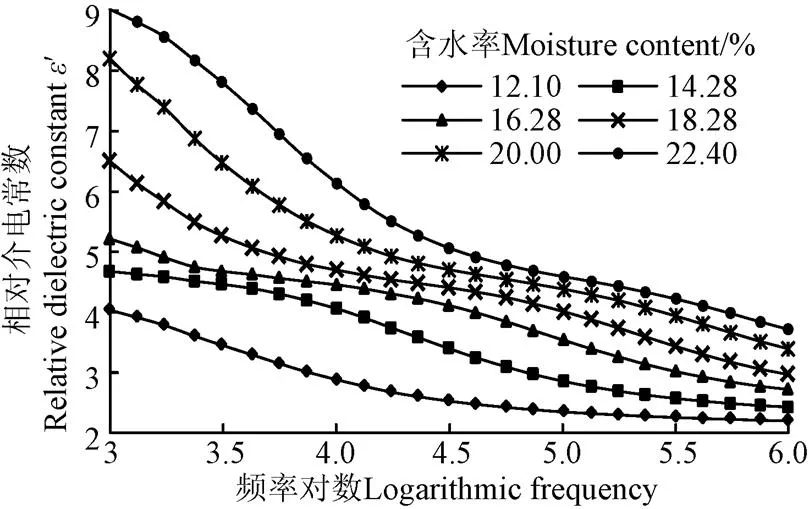
图2 频率对不同含水率水稻ε′的影响曲线
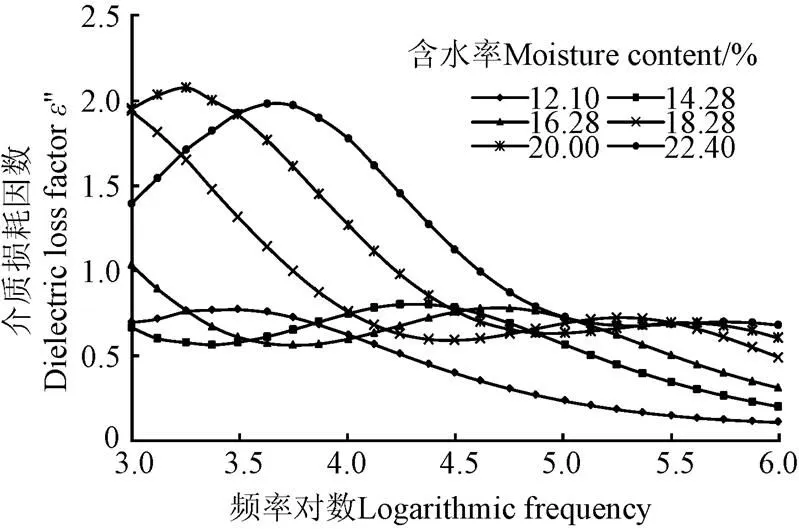
图3 频率对不同含水率水稻ε"的影响曲线
由图3可知,在1 kHz~1 MHz频段内,不同含水率水稻随频率变化规律不一致,原因是频率范围过窄。当含水率不同时,水稻内部水分运移情况不同,导致内部水分分布不均匀,松弛时间不同,从而导致在不同频率下出现波峰。当频率大于300 kHz时,随着频率的增大而减小,随含水率的增大而增大。主要由离子传导导致,随着频率的升高,离子导电性增强,变小。通过方差分析,频率和含水率对水稻影响均极显著(<0.01)。
2.2 样本集的划分
为使校正集样本更具有代表性,本研究采用距离法(sample set partitioning based on joint-distances,SPXY)来对120个不同含水率样本进行划分。划分比例3:2。SPXY算法以经典Kennard- Stone算法为基础,综合考虑介电参数和含水率的欧氏距离,从而完成样本集的划分[35]。划分结果见表1。

表1 校正集和预测集含水率统计结果
由表1可以看出,本研究共划分72个样本作为校正集,48个样本作为预测集。校正集与预测集样本中含水率变化范围较大,说明样本集具有一定的代表性,满足了建立校正集含水率预测模型的基本条件。
2.3 特征变量的选取
2.3.1 无信息变量消除法选取结果
首先,采用五折交叉验证法确定,以及两者结合变量的UVE因子数分别为7、9、6。的UVE选取结果见图4。
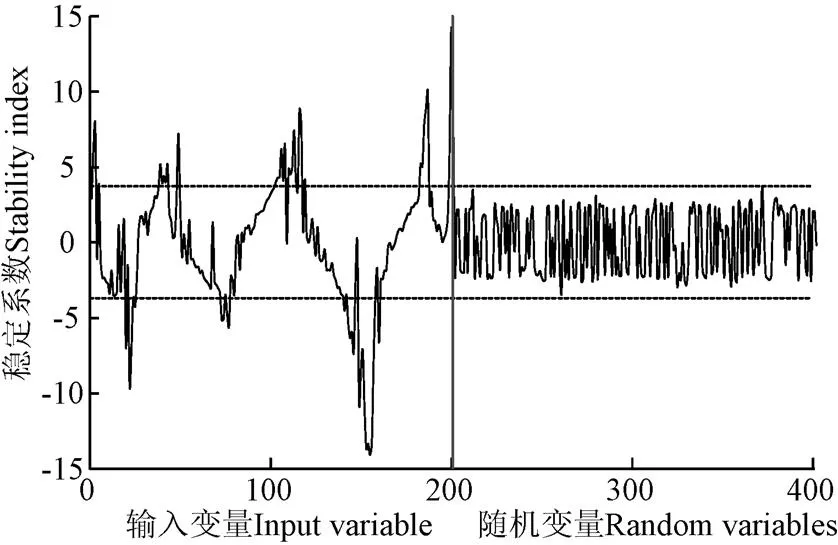
图4 ε′的稳定性分布曲线
竖线左右两侧分别为输入变量及随机变量的稳定性曲线,、及和结合变量的稳定性分布曲线分别包括201(201个频率点下的)、201(201个频率点下的)、402个输入变量(201个频率点下的和)和201、201、402个随机变量。虚线为变量选择的阈值,2条阈值线间的变量为无信息变量,选择2条阈值线外的输入变量作为特征变量。最终确定,及两者结合变量的特征变量数及所选频率点见表2。
2.3.2 连续投影法选取结果
为保证模型的可靠性,设置SPA的特征变量数范围为2~20。以RMSEC值作为选取特征变量数的指标。RMSEC随SPA选取特征变量数的变化曲线如图5所示。
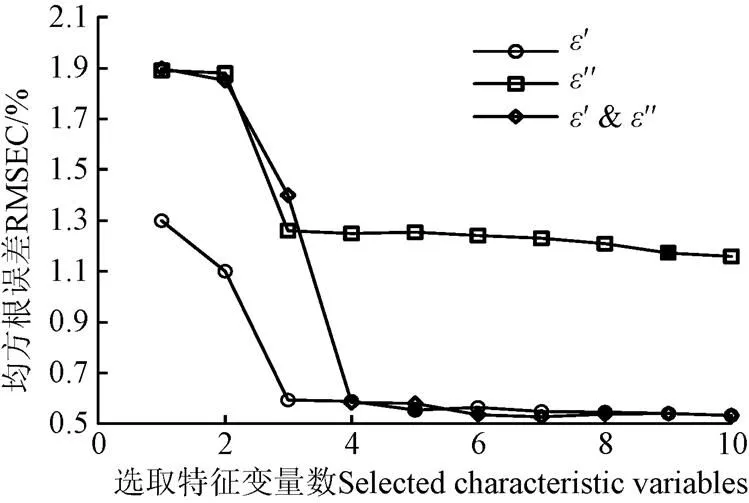
图5 RMSEC随SPA选取变量数的变化曲线
由图5可知,随着选取变量数的增加,RMSEC逐渐减小,以RMSEC不再显著减小时的变量数作为特征变量数。考虑到变量选取过多会导致模型的复杂度上升,最终确定、及两者结合变量经SPA选取的特征变量数分别为5、9和6个;所对应的校正均方根误差分别为0.555%、1.172%、0.536%。各特征变量所对应的频率见表2。
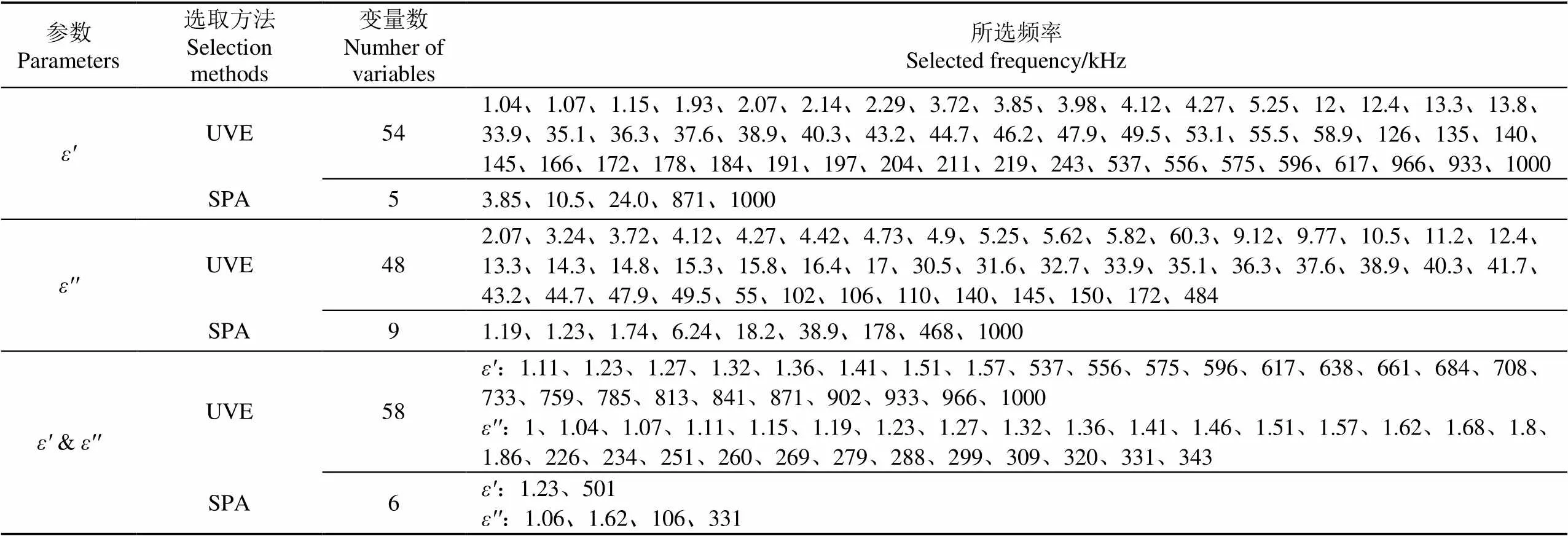
表2 UVE 与SPA选取的特征变量
2.4 多元回归模型预测结果的比较分析
,经SPA选取的特征变量所对应的频率中都包括1 MHz,且在1 MHz频率下,不同含水率水稻的,′′有明显差异,故选择1 MHz作为单频的特征频率。
为提高模型的稳定性及准确性,本研究采用径向基核函数来建立SVR模型,并以校正集样本为对象,采用六折交叉验证法优化SVR模型的惩罚因子()和松弛变量(),,优化结果如表3所示。分别以全频、单频下的介电参数(,,和结合)以及经SPA和UVE选取的特征变量作为因变量建立MLR、SVR模型。建模结果如表3所示。

表3 多元回归模型预测结果及参数优化汇总表
从选取变量角度来看,采用全频变量建立的MLR模型R2达到1,RMSEC极小,而R2较R2显著降低,主要原因是模型中存在过多的线性变量,导致MLR模型出现过拟合现象,从而导致模型泛化能力下降。对于SVR模型,建模时选取的变量数越多,模型的R2越高,RMSEP越小。采用全频变量建立的SVR模型预测效果最佳,3种介电参数预测集R2分别达到0.982、0.974、0.983,说明SVR解决了全频下MLR模型中出现的过拟合问题。虽采用全频变量建立的SVR模型的R2最大,但考虑到全频谱中包含大量冗余信息,增大模型运算量,不宜采用。UVE和SPA均能有效提取原始变量中的有用信息,但SPA较UVE能更有效提取全频谱中的特征变量,主要因SPA能剔除大量无用信息,解决变量间存在的共线性问题。3种介电参数(,,和结合)在单频下建立的模型更简单,较经SPA提取特征变量建立的模型预测精度有所下降。从介电参数的角度来看,和均能预测水稻含水率,但采用和两者结合建立的模型预测精度更高,预测效果优于单一介电参数,主要因两者结合能够进行信息互补,提高模型的预测性能。从建模方法来看,虽采用SVR建立的水稻含水率模型的预测准确度优于MLR,但MLR模型更简单、具体且形象。从模型的预测效果及复杂度来看,采用和两者结合并利用SPA选取变量建立的SVR模型预测效果最优,预测集R2达到0.980,RMSEP为0.403%。因此,最终选择和相结合并基于SPA建立的SVR模型作为预测水稻含水率的最佳模型。预测集含水率的预测结果如图6所示。

图6 ε′和ε′′相结合的SPA-SVR模型含水率预测结果
2.5 水稻温度特性试验
考虑到温度对介电参数有影响,需分析最佳模型下含水率预测值随温度的变化规律,并对模型的含水率预测结果进行温度补偿。
试验温度10 ℃~30 ℃,以5 ℃为梯度调节气候箱温度,测量5组水稻含水率样品在5个不同温度下的介电参数,利用预测模型计算不同温度下样品的含水率,并与烘干法测得的含水率实测值进行比较分析。不同温度下水稻含水率预测值的变化规律如图7所示。
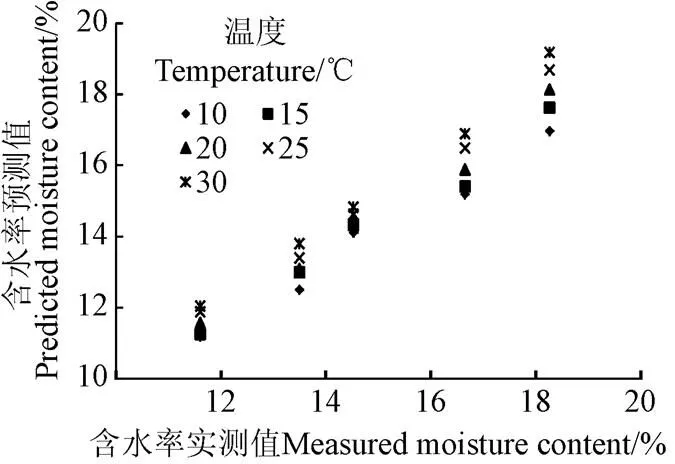
图7 不同温度下含水率变化曲线
由图7可知,温度越高,模型的含水率预测值越大。在每个温度梯度下,模型的含水率预测值与实测值呈线性关系,采用最小二乘法进行线性回归分析,并计算出线性回归系数、。不同温度下的回归结果见表4。

表4 不同温度下的回归系数
表4中温度每上升5℃,斜率的变化为0.057,0.049,0.050,0.044,平均值0.050;的变化为−0.522,−0.403,−0.369,−0.325,平均值−0.404。计算得回归系数的平均变化率分别为Δ=0.050,Δ=−0.404。由Δ,Δ计算23 ℃下的、,得到水稻含水率预测值的温度补偿模型为

整理得

式中h为含水率预测值,%;h为温度补偿后的含水率值,%;为温度,℃。
2.6 模型验证
为探究最佳预测模型对不同品种水稻含水率的预测效果,分别以超产1号、临稻、铁粳15为对象,随机配制158份不同含水率的样品,含水率范围9%~23%。在23 ℃下,测量介电参数并利用预测模型计算其含水率。图8统计了样本含水率的预测值与烘干法测得的实测值的绝对误差水平,绝对误差范围为−1.14%~1.17%。最佳模型预测水稻含水率的绝对误差集中分布在±0.5%内。说明采用和相结合并利用SPA提取特征变量建立的SVR模型作为水分检测模型时,水稻含水率预测准确度较高。
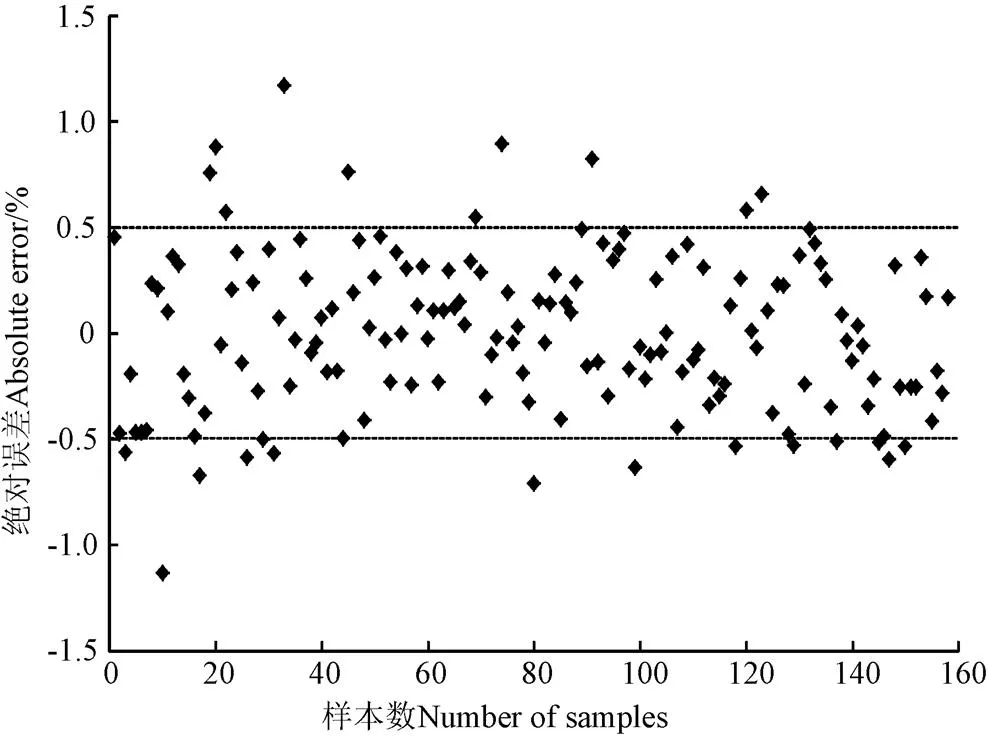
注:虚线为国家电容法水分测定仪二级准确度标准,取值为±0.5%。
3 结 论
1)通过探究含水率和频率对水稻介电参数的影响发现,在1 kHz~1 MHz频率范围内,相对介电常数随频率的增大而减小,随含水率的增大而增大。当频率大于300 kHz时,介质损耗因数随着频率的增大而减小,随含水率的增大而增大。频率和含水率对相对介电常数和介质损耗因数的影响均极显著。
2)以120份不同含水率的水稻样品为研究对象,通过对比不同介电参数在不同频率下建立模型的预测效果发现:相比于单一频率下的单一介电参数,利用多频下相对介电常数和介质损耗因数相结合的变量作为因变量建立的非线性模型的预测性能最优。且当采用不同处理方法来提取介电参数的特征变量时,连续投影法较无信息变量消除法能更有效地筛选出特征变量,降低模型复杂度。通过对模型的预测性能进行分析得出:采用相对介电常数和介质损耗因数相结合并利用连续投影法提取特征变量建立的支持向量机回归模型预测效果最佳,预测集的决定系数达到0.980,预测均方根误差为0.403%。
3)采用最小二乘回归法对模型在不同温度下水稻含水率预测值进行温度修正,当采用最佳模型来预测158份不同品种的水稻含水率时,预测结果较准确,同烘干法测得的实测含水率相比较,预测误差集中分布在±0.5%内。
[1] 赵博,毛文华,胡小安,等. 粮食收购品质自动评定装置设计与试验[J]. 农业机械学报,2010,41(S1):268-271,276.
Zhao Bo, Mao Wenhua, Hu Xiaoan, et al. Design and experiment of automatic quality grading equipment in grain purchase[J]. Transactions of the Chinese Society for Agricultural Machinery, 2010, 41(S1): 268-271, 276. (in Chinese with English abstract)
[2] 高利伟,许世卫,李哲敏,等. 中国主要粮食作物产后损失特征及减损潜力研究[J]. 农业工程学报,2016,32(23):1-11.
Gao Liwei, Xu Shiwei, Li Zhemin, et al. Main grain crop postharvest losses and its reducing potential in China[J]. Transactions of the Chinese Society of Agricultural Engineering (Transactions of the CSAE), 2016, 32(23): 1-11. (in Chinese with English abstract)
[3] 宋平,彭宇飞,王桂红,等. 玉米种子萌发过程内部水分流动规律的低场核磁共振检测[J]. 农业工程学报,2018,34(10):282-289.
Song Ping, Peng Yufei, Wang Guihong, et al. Detection of internal water flow in germinating corn seeds based on low field nuclear magnetic resonance[J]. Transactions of the Chinese Society of Agricultural Engineering (Transactions of the CSAE), 2018, 34(10): 282-289. (in Chinese with English abstract)
[4] Kovaleva A A, Saitov R I, Zaporozhets A S, et al. Microwave moisture meter for cereal grains[J]. Measurement Techniques, 2017, 59(10): 1056-1060.
[5] 黄华,吴习宇,祝诗平. 近红外光谱预测稻谷水分含量特征谱区选择及其效率分析[J]. 光谱学与光谱分析,2018,38(4):1070-1075.
Huang Hua, Wu Xiyu, Zhu Shiping. Feature wavelength selection and efficiency analysis for paddy moisture content prediction by near infrared spectroscopy [J]. Spectroscopy and Spectral Analysis, 2018, 38(4):1070-1075.
[6] 杨悦乾,王剑平,王成芝. 谷物含水率中子法在线测量的可行性研究[J]. 农业工程学报,2000,16(5):99-101.
Yang Yueqian, Wang Jianping, Wang Chengzhi. Study on on-line measurement of grain moisture content by neutron gauge[J]. Transactions of the Chinese Society of Agricultural Engineering (Transactions of the CSAE), 2000, 16(5): 99-101. (in Chinese with English abstract)
[7] 宋琦,卢泽民,孙卫红,等. 水稻电阻抗谱分析及检测频率范围的确定[J]. 农机化研究,2018,40(4):172-176.
Song Qi, Lu Zemin, Sun Weihong, et al. Electrical impedance spectroscopy analysis of rice and determination of detection frequency range[J]. Journal of Agricultural Mechanization Research, 2018, 40(4): 172-176. (in Chinese with English abstract)
[8] 赵丽清,尚书旗,高连兴,等. 基于同心轴圆筒式电容传感器的花生仁水分无损检测技术[J]. 农业工程学报,2016,32(9):212-218.
Zhao Liqing, Shang Shuqi, Gao Lianxing, et al. Nondestructive measurement of moisture content of peanut kernels based on concentric cylindrical capacitance[J]. Transactions of the Chinese Society of Agricultural Engineering (Transactions of the CSAE), 2016, 32(9): 212-218. (in Chinese with English abstract)
[9] 陈进,王月红,练毅,等. 高频电容式联合收获机谷物含水量在线监测装置研制[J]. 农业工程学报,2018,34(10):36-45.
Chen Jin, Wang Yuehong, Lian Yi, et al. Development of on-line monitoring device of grain moisture content in combine harvester with high frequency capacitance[J]. Transactions of the Chinese Society of Agricultural Engineering (Transactions of the CSAE), 2018, 34(10): 36-45. (in Chinese with English abstract)
[10] 黄滔,赵春宇,朱成刚,等. 同面弧面电容式种子水分传感器的研究[J]. 农机化研究,2016,38(11):252-256.
Huang Tao, Zhao Chunyu, Zhu Chenggang, et al. Study on uniplanar cambered capacitive sensor of seed moisture content[J]. Journal of Agricultural Mechanization Research, 2016, 38(11): 252-256. (in Chinese with English abstract)
[11] 刘志壮,朱湘萍,张文昭,等. 介电法小麦含水率检测试验研究[J]. 传感技术学报,2017,30(12):1857-1861.
Liu Zhizhuang, Zhu Xiangping, Zhang Wenzhao, et al. Wheat moisture content detection based on dielectric constant[J]. Chinese Journal of Sensors and Actuators, 2017, 30(12): 1857-1861. (in Chinese with English abstract)
[12] 刘志壮,吕贵勇. 基于电容法的稻谷含水率检测[J]. 农业机械学报,2013,44(7):179-182.
Liu Zhizhuang, Lui Guiyong. Mositure content detection of paddy rice based on capacitande approach[J]. Transactions of the Chinese Society for Agricultural Machinery, 2013, 44(7): 179-182. (in Chinese with English abstract)
[13] 陈建国,李彦明,覃程锦,等. 小麦播种量电容法检测系统设计与试验[J]. 农业工程学报,2018,34(18):51-58.
Chen Jianguo, Li Yanming, Qin Chengjin, et al. Design and test of capacitive detection system for wheat seeding quantity[J]. Transactions of the Chinese Society of Agricultural Engineering (Transactions of the CSAE), 2018, 34(18): 51-58. (in Chinese with English abstract)
[14] 闫华,邢振,薛绪掌,等. 土壤剖面水分传感器探头仿真与试验[J]. 农业机械学报,2017,48(10):244-251.
Yan Hua, Xing Zhen, Xue Xuzhang, et al. Simulation and experiment on soil moisture profile sensor probe[J]. Transactions of the Chinese Society for Agricultural Machinery, 2017, 48(10): 244-251. (in Chinese with English abstract)
[15] 徐冬平,张鹏鹏,孙诗裕. 基于FDC1004的电容式谷物水分检测仪的设计[J]. 农机化研究,2016,38(8):173-178.
Xue Dongping, Zhang Pengpeng, Sun Shiyu. Design of a grain moisture detector based on dielectric character[J]. Journal of Agricultural Mechanization Research, 2016, 38(8): 173-178. (in Chinese with English abstract)
[16] 杨柳,毛志怀,董兰兰. 电容式谷物水分传感器平面探头的研制[J]. 农业工程学报,2010,26(2):185-189.
Yang Liu, Mao Zhihuai, Dong Lanlan. Development of plane polar probe of capacitive grain moisture sensor[J]. Transactions of the Chinese Society of Agricultural Engineering (Transactions of the CSAE), 2010, 26(2): 185-189. (in Chinese with English abstract)
[17] 郭交,段凯文,郭文川. 基于微波自由空间测量的小麦含水率检测方法[J]. 农业机械学报,2019,50(6):338-343,378.
Guo Jiao, Duan Kaiwen, Guo Wenchuan. Detection method of moisture content of wheat with microwave free-space measurement[J].Transactions of the Chinese Society for Agricultural Machinery, 2019, 50(6):338-343, 378.
[18] Ling Bo, Guo Wenchuan, Hou Lixia, et al. Dielectric properties of pistachio kernels as influenced by frequency, temperature, moisture and salt content[J]. Food and Bioprocess Technology, 2015, 8(2): 420-430.
[19] Boreddy S R, Subbiah J. Temperature and moisture dependent dielectric properties of egg white powder[J]. Journal of Food Engineering, 2016, 168: 60-67.
[20] Ling Bo, Liu Xiaoli, Zhang Lihui, et al. Effects of temperature, moisture, and metal salt content on dielectric properties of rice bran associated with radio frequency heating[J]. Scientific Reports, 2018, 8(1): 1-12.
[21] Chinma C E, RamakrishnanY. Properties of cereal brans: A review[J]. Cereal Chem, 2015, 92(1): 1-7.
[22] Bo L, Lyng J G, Shaojin W. Radio-frequency treatment for stabilization of wheat germ: Dielectric properties and heating uniformity[J]. Innovative Food Science & Emerging Technologies, 2018, 48: 66-74.
[23] 麦智炜,李长友,徐凤英,等. 浮地式粮食水分在线检测装置设计与试验[J]. 农业机械学报,2014,45(10):207-213.
Mai Zhiwei, Li Changyou, Xue Fengying, et al. Design and test of grain moisture online measuring system based on floating ground capacitance[J]. Transactions of the Chinese Society for Agricultural Machinery, 2014, 45(10): 207-213. (in Chinese with English abstract)
[24] 郭文川,刘驰,杨军. 小麦秸秆含水率测量仪的设计与试验[J]. 农业工程学报,2013,29(1):33-40.
Guo Wenchuan, Liu Chi, Yang Jun. Design and experiment on wheat straw moisture content meter[J]. Transactions of the Chinese Society of Agricultural Engineering (Transactions of the CSAE), 2013, 29(1): 33-40. (in Chinese with English abstract)
[25] 郭文川,赵志翔,杨沉陈. 基于介电特性的小杂粮含水率检测仪设计与试验[J]. 农业机械学报,2013,44(5):188-193.
Guo Wenchuan, Zhao Zhixiang, Yang Chenchen. Moisture meter for coarse cereals based on dielectric property[J]. Transactions of the Chinese Society for Agricultural Machinery, 2013, 44(5): 188-193. (in Chinese with English abstract)
[26] 李靖轩,冷文秀. 基于圆筒形电容器的粮食含水率测定研究[J]. 物理与工程,2019,29(1):73-78.
Li Jingxuan, Leng Wenxiu. Study on determination of grain moisture content based on cylindrical capaitor[J]. Physics and Engineering, 2019, 29(1): 73-89. (in Chinese with English abstract)
[27] 鄂旭,翟宝峰,徐进,等. 一种新型食品安全存储中的水分检测方法[J]. 计算机技术与发展,2014,24(2):220-223.
E Xu, Zhai Baofeng, Xu Jin, et al. A new method of water-containing detection for food safety storage[J]. Computer Technology and Development, 2014, 24(2): 220-223. (in Chinese with English abstract)
[28] 张妤,谢永华,穆丽新,等. 基于支持向量机的电容式传感器温度补偿研究[J]. 传感器与微系统,2009,28(6):40-42.
Zhang Yu, Xie Yonghua, Mu Lixin, et al. Study on temperature compensation for capacitance sensor based on support vector machine[J]. Transducer and Microsystem Technologies, 2009, 28(6): 40-42. (in Chinese with English abstract)
[29] Solar M, Solar A. Non-destructive determination of moisture content in hazelnut[J]. Computers and Electronics in Agriculture, 2016, 121(2): 320-330.
[30] 史晏泽. 粮食水分测量仪的设计与实现[D]. 长春:吉林大学,2018.
Shi Yanze. Design and Implementation of Food Moisture Meter[D]. Changchun: Jilin University, 2018.
[31] 孙俊,莫云南,戴春霞,等. 基于介电特性与IRIV-GWO-SVR算法的番茄叶片含水率检测[J]. 农业工程学报,2018,34(14):188-195.
Sun Jun, Mo Yunnan, Dai Chunxia, et al. Detection of moisture content of tomato leaves based on dielectric properties and IRIV-GWO-SVR algorithm[J]. Transactions of the Chinese Society of Agricultural Engineering (Transactions of the CSAE), 2018, 34(14): 188-195. (in Chinese with English abstract)
[32] 王转卫,赵春江,商亮,等. 基于介电频谱技术的甜瓜品种无损检测[J]. 农业工程学报,2017,33(9):290-295.
Wang Chuanwei, Zhao Chunjiang, Shang Liang, et al. Nondestructive testing of muskmelons varieties based on dielectric spectrum technology[J]. Transactions of the Chinese Society of Agricultural Engineering (Transactions of the CSAE), 2017, 33(9): 290-295. (in Chinese with English abstract)
[33] 商亮,谷静思,郭文川. 基于介电特性及ANN的油桃糖度无损检测方法[J]. 农业工程学报,2013,29(17):257-264.
Shang Liang, Gu Jingsi, Guo Wenchuan. Non-destructively detecting sugar content of nectarines based on dielectric properties and ANN[J]. Transactions of the Chinese Society of Agricultural Engineering (Transactions of the CSAE), 2013, 29(17): 257-264. (in Chinese with English abstract)
[34] 郭文川,王东阳,孔繁荣,等. 基于介电特性的豆浆固形物含量检测[J]. 农业机械学报,2016,47(7):239-245.
Guo Wenchuan, Wang Dongyang, Kong Fanrong, et al. Solids content detection of soybean milk based on permittivities[J]. Transactions of the Chinese Society for Agricultural Machinery, 2016, 47(7): 239-245. (in Chinese with English abstract)
[35] Galvao R K H, Araujo M C U, Jose G E, et al. A method for calibration and validation subset partitioning[J]. Talanta, 2005, 67(4): 736-740.
Rice moisture content detection method based on dielectric properties and SPA-SVR algorithm
Zhang Benhua,Qian Changqian, Jiao Jinkang, Ding Zhaohe, Zhang Yang, Cui Hongguang, Liu Cuihong, Feng Longlong
(,,110161,)
Water content affects rice quality, which also has an important impact on rice storage, transportation, acquisition and processing. The annual loss of production caused by grain deterioration was up to 10 million tons, and the economic loss was up to 20 billion. Therefore, detecting rice moisture content accurately is beneficial to improve rice quality and reduce yield loss. A new method based on dielectric properties was proposed to detect the moisture content of rice in this study. Firstly, the dielectric properties (relative dielectric constant and dielectric loss factor) of 120 copies of rice of Japonica No.3 with different moisture contents were measured with impedance analyzer and self-made coaxial cylindrical capacitor at 201 discrete frequencies over the frequency range of 1 kHz-1 MHz, and the moisture contents of rice were measured by dry weight method. Secondly, sample set partitioning based on joint-distances (SPXY) was used to subset partitioning. Uninformative variables elimination (UVE) and successive projection algorithm (SPA) were applied to extract the characteristic variables of dielectric parameters ((the relative dielectric constant, dielectric loss factor and relative dielectric constant combined with dielectric loss factor). And the effect of SPA was compared with that of UVE to determine the optimal method for characteristic variable selection simultaneously. Finally, the support vector regression (SVR) machine and multiple linear regression (MLR) were adopted to establish the relationship models with two kinds of characteristic variables, single variables and full variables for predicting rice moisture content. And the performances of all the models were evaluated by the determination coefficient and root mean square error for calibration set and prediction set. The least square method was used for linear regression of predicted moisture content and measured moisture content at different temperatures, and the temperature compensation was carried out for the prediction results. The performances of the best model to predict different varieties of rice moisture content were explored to determine the applicability of the model. The research results showed that the relative dielectric constant decreased with the increase of the measurement frequency between 1kHz and 1MHz. When the frequency was greater than 300 kHz, the dielectric loss factor decreased with the increase of frequency and increased with the increase of water content. The measurement frequency and moisture content had an obvious effect on the dielectric properties of rice. Based on SPXY, 72 samples were partitioned to a calibration set and 48 samples to a prediction set. SPA was more effective than UVE in selecting useful information from the whole spectra of dielectric constant and dielectric loss factor. The model established by using the combination of relative dielectric constant and dielectric loss factor at multiple frequencies had better performance in predicting moisture content, which compared with the single dielectric parameter at a single frequency. Compared with MLR, SVR had better performance in predicting moisture content. The results showed that the support vector machine regression model based on the combination of relative dielectric constant and dielectric loss factorand SPA gave the highest correlation coefficient of predication set (0.980) and the lowest root mean square error of predication set (0.403%). When the best model was used to predict the water content of different varieties of rice, the prediction results were more accurate. Compared with the measured water content by the drying method, the prediction error was concentrated within ±0.5%. The study provided a reference for improving the accuracy of the grain moisture detection device.
water content; rice; dielectric properties; successive projection algorithm; support vector regression
张本华,钱长钱,焦晋康,丁兆赫,张 扬,崔红光,刘翠红,冯龙龙. 基于介电特性与SPA-SVR算法的水稻含水率检测方法[J]. 农业工程学报,2019,35(18):237-244.doi:10.11975/j.issn.1002-6819.2019.18.029 http://www.tcsae.org
Zhang Benhua, Qian Changqian, Jiao Jinkang, Ding Zhaohe, Zhang Yang, Cui Hongguang, Liu Cuihong, Feng Longlong. Rice moisture content detection method based on dielectric properties and SPA-SVR algorithm[J]. Transactions of the Chinese Society of Agricultural Engineering (Transactions of the CSAE), 2019, 35(18): 237-244. (in Chinese with English abstract) doi:10.11975/j.issn.1002-6819.2019.18.029 http://www.tcsae.org
2019-05-19
2019-08-25
国家重点研发计划(2018YFD0300309-01)
张本华,教授,博士,主要从事农业机械化方面研究。Email:zbh@syau.edu.cn
10.11975/j.issn.1002-6819.2019.18.029
S233.71
A
1002-6819(2019)-19-0237-08

